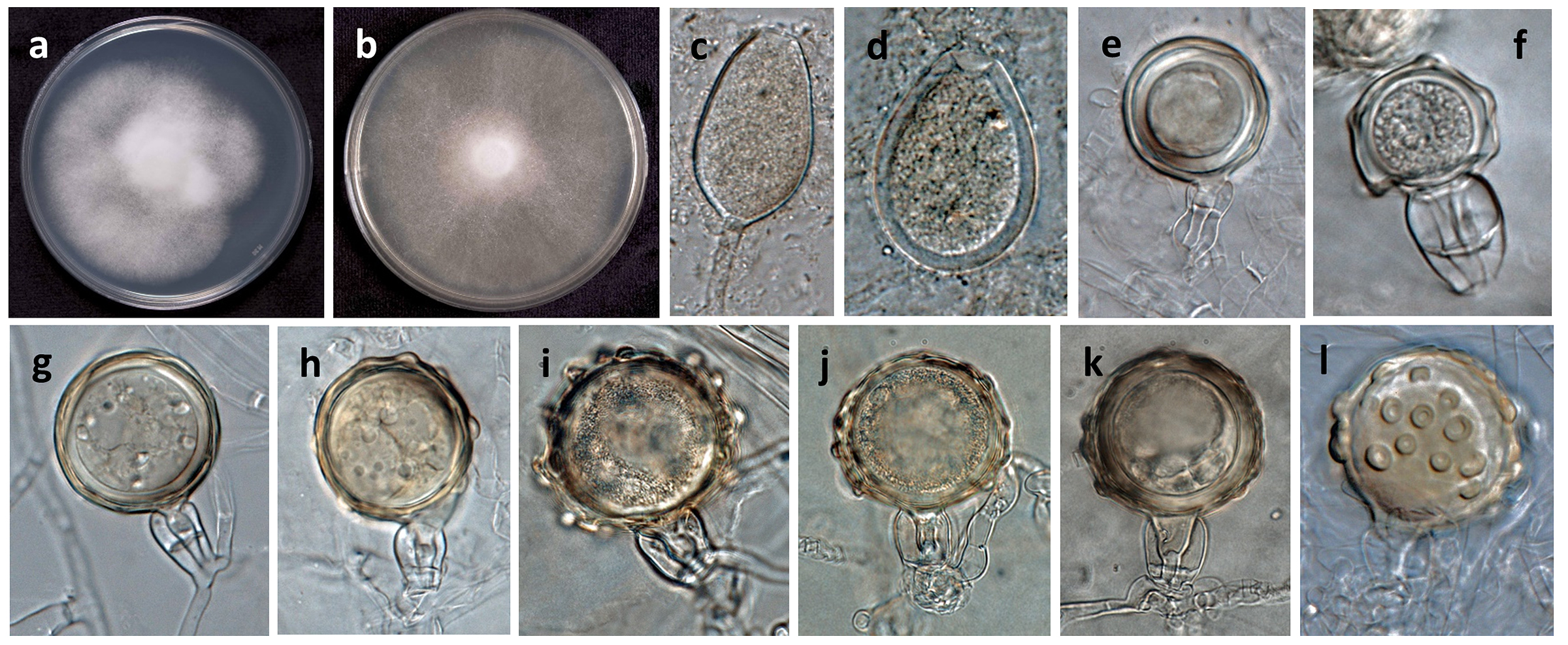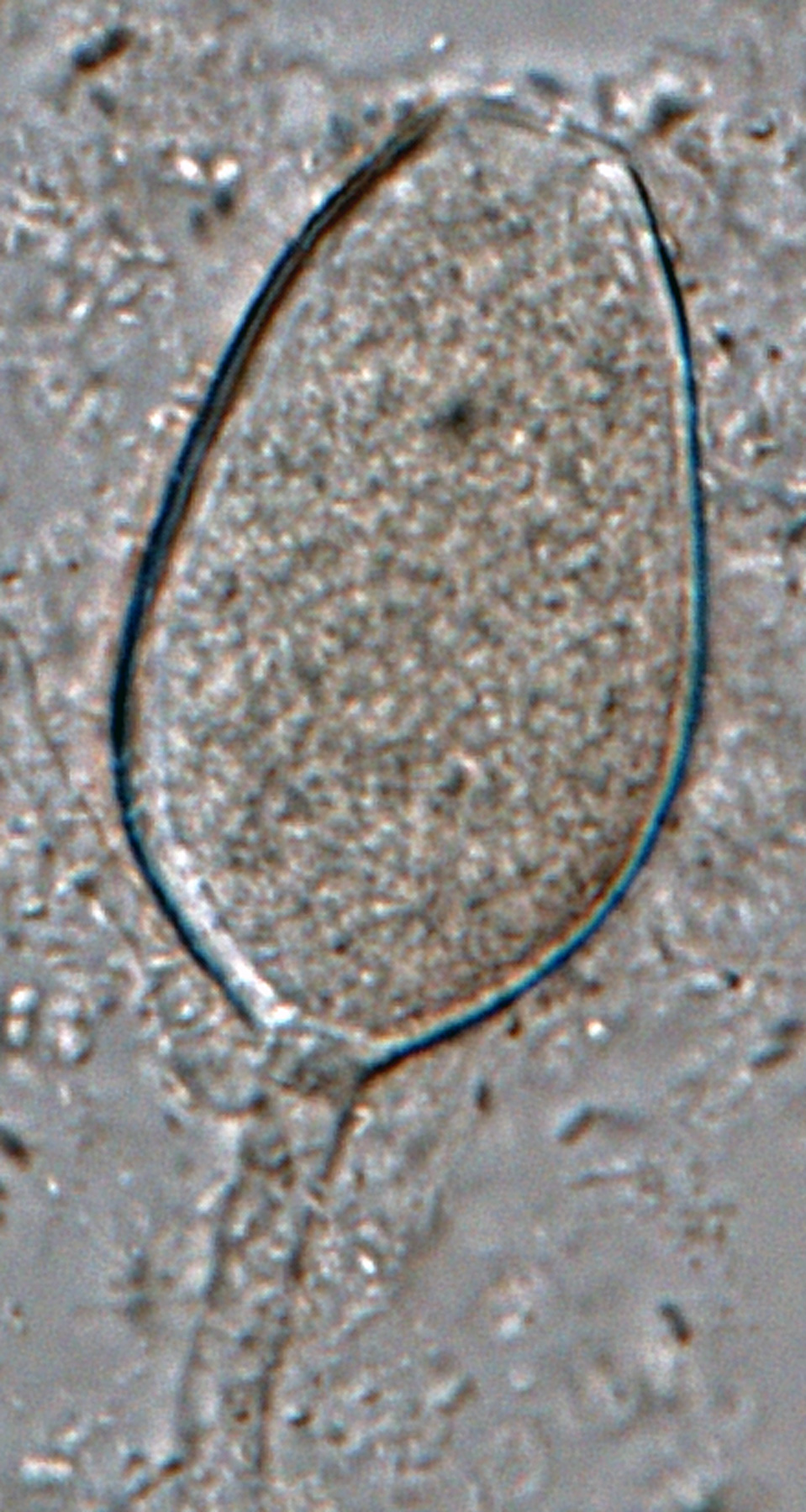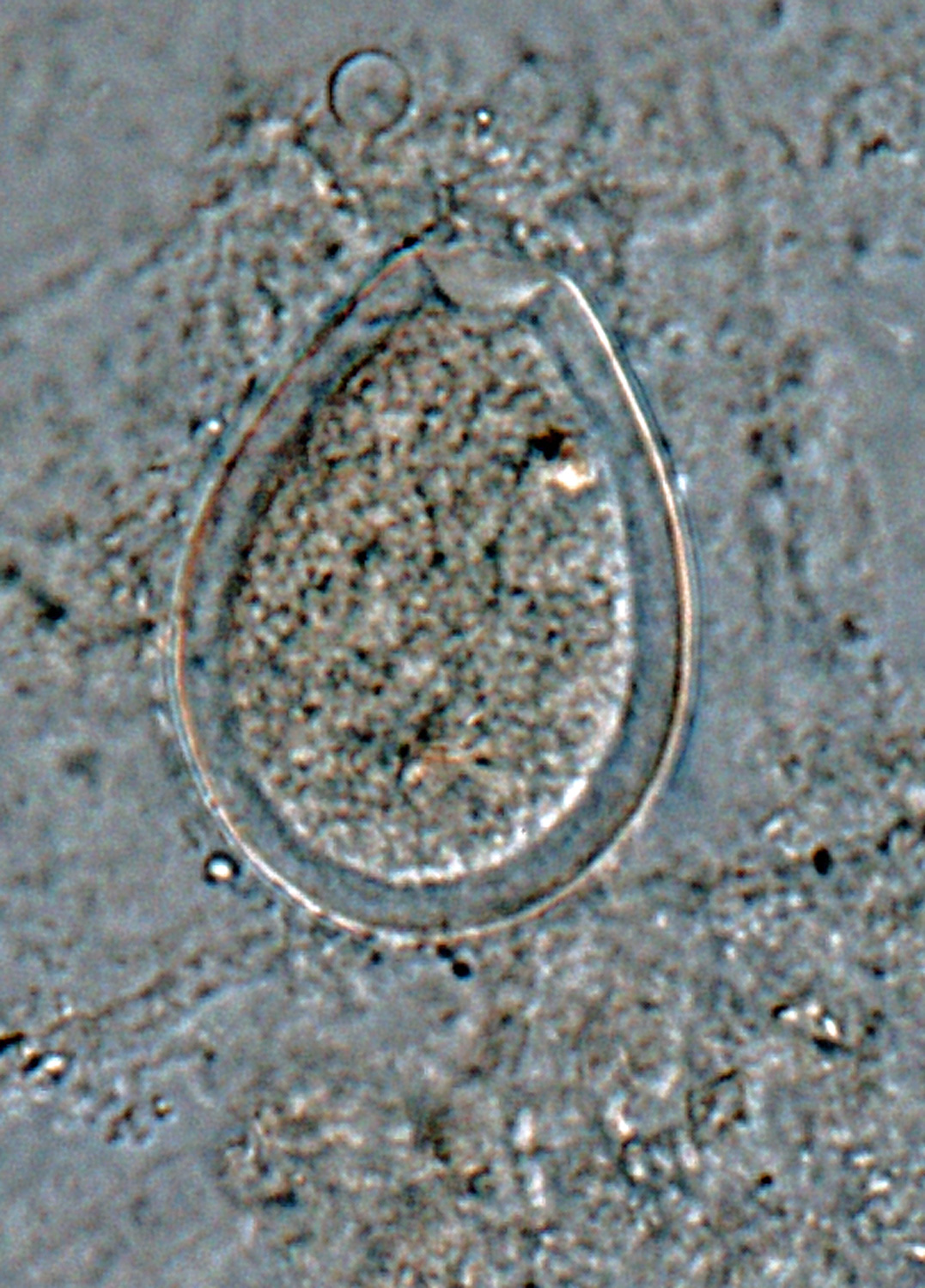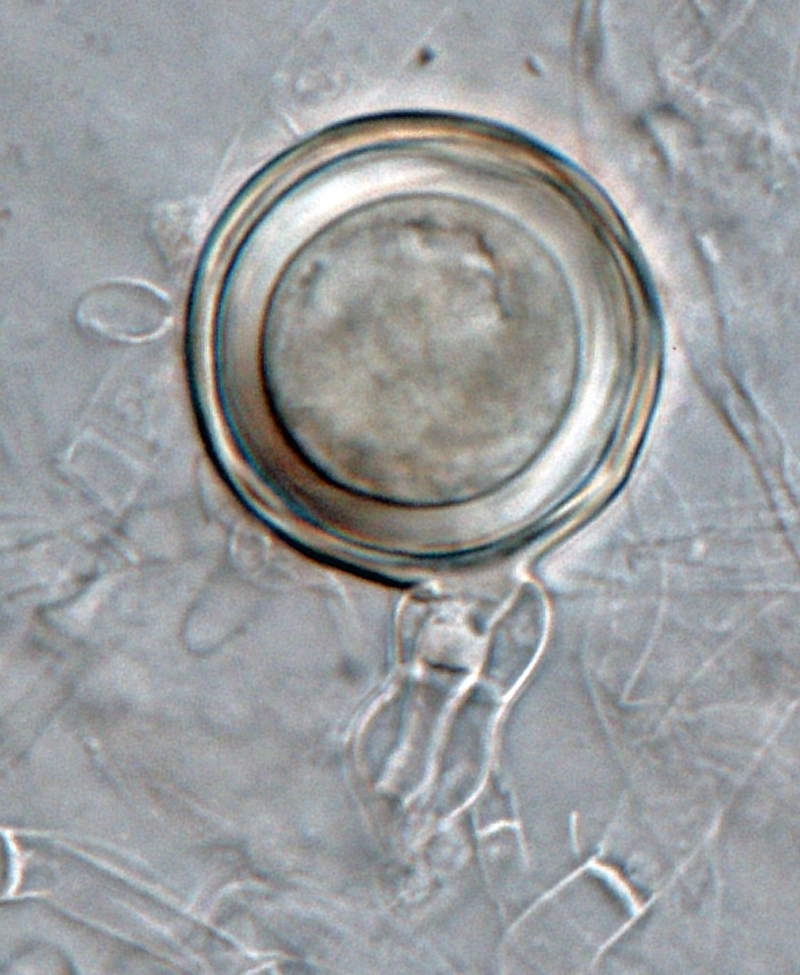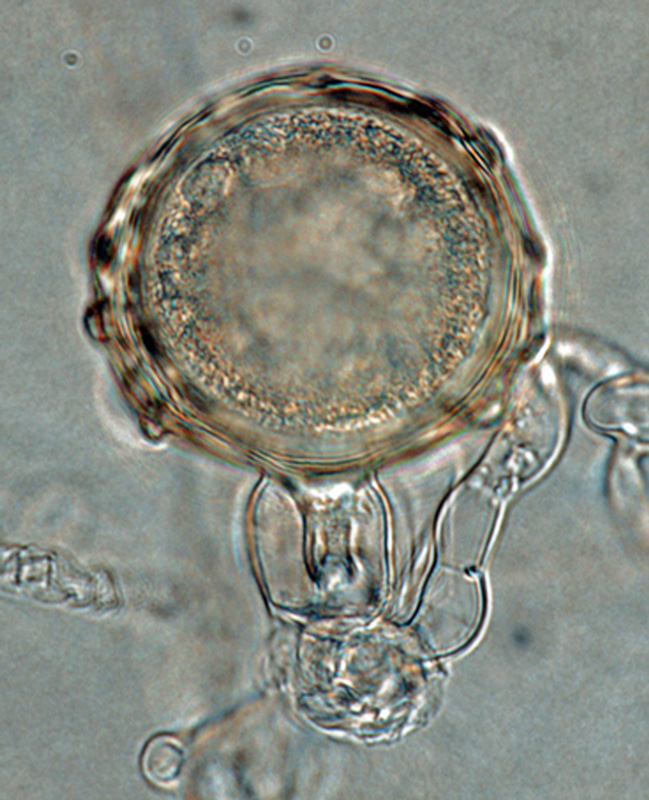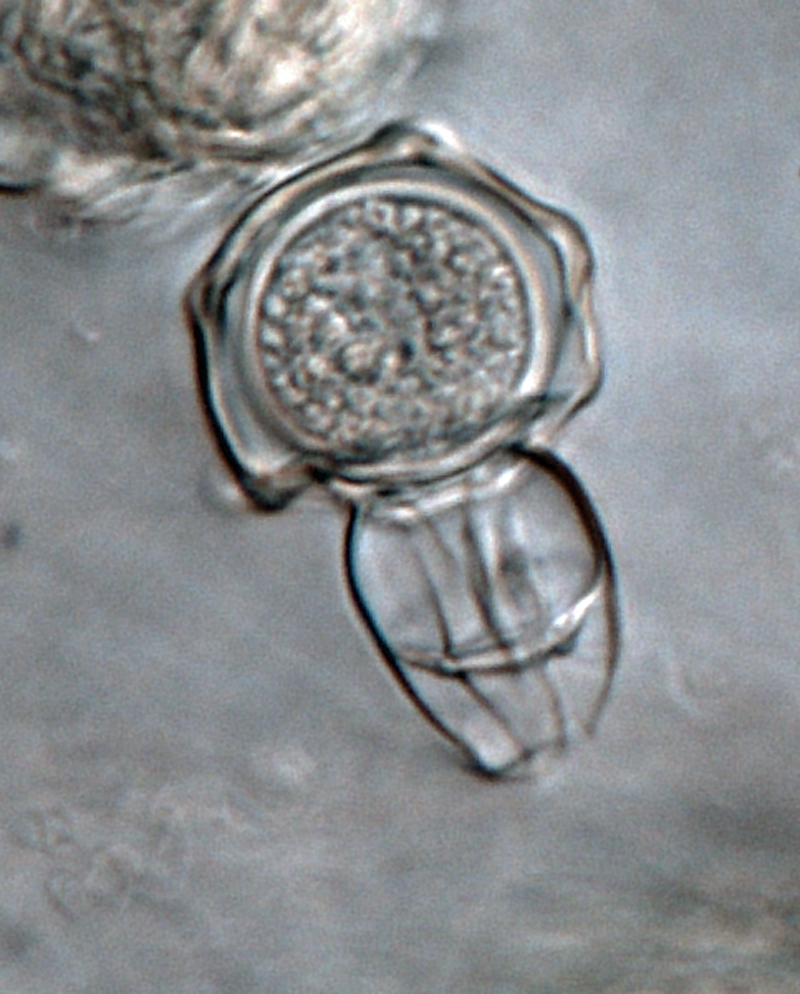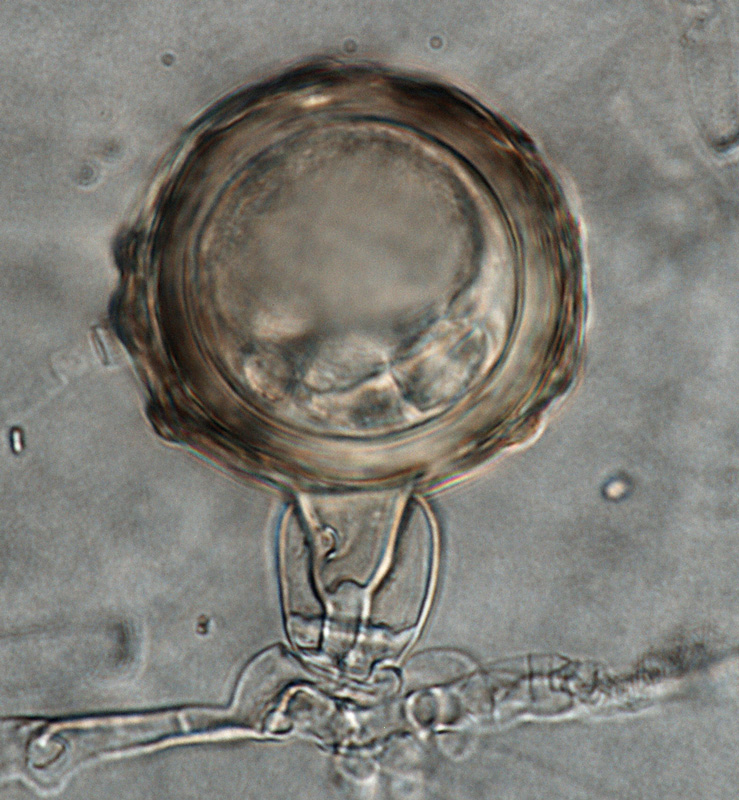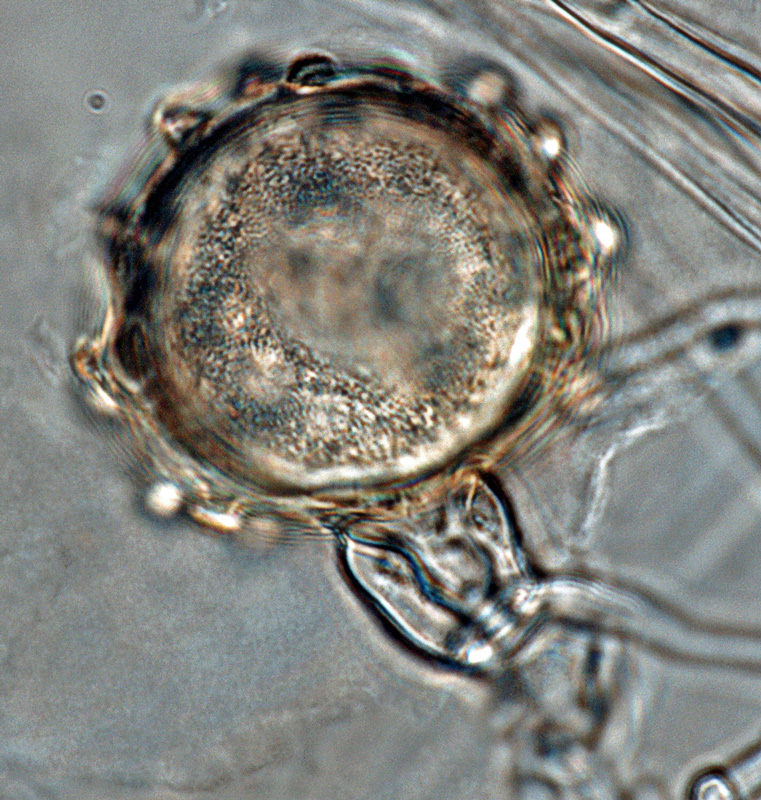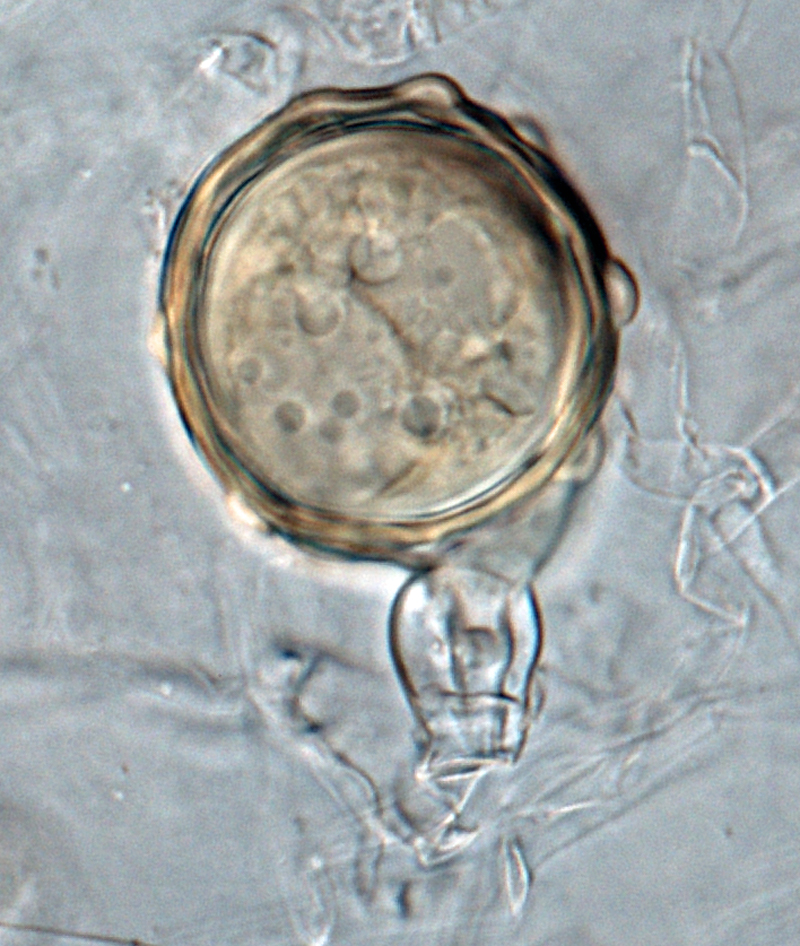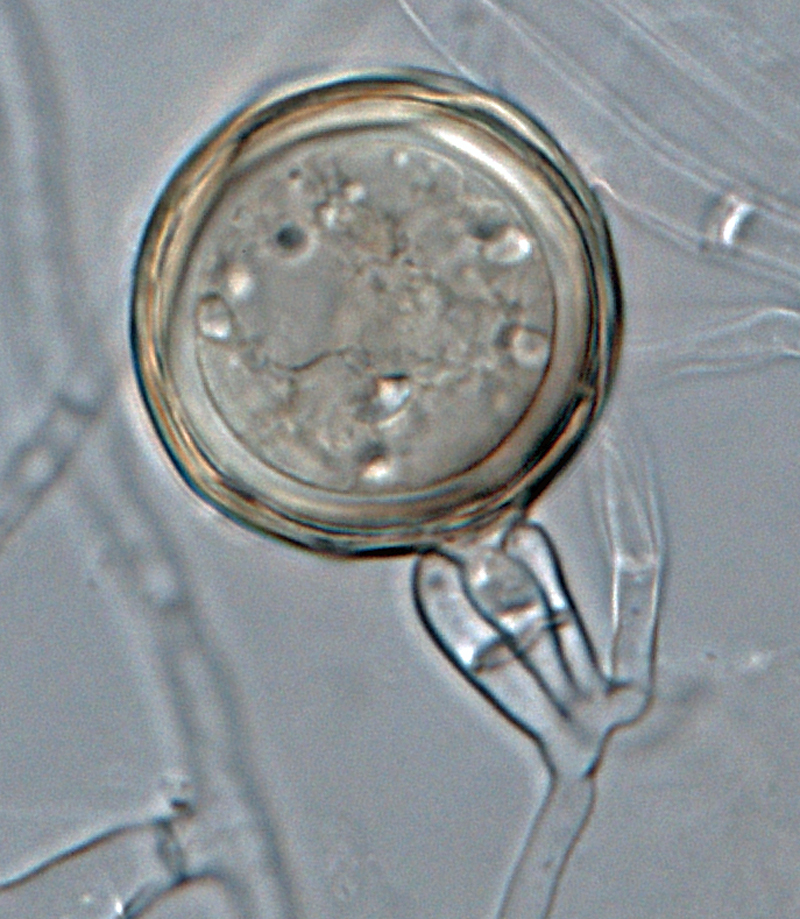Phytophthora ×alni
|
Phytophthora spp. in subclade 7a: portion of the seven-loci ML phylogeny featuring the type cultures of 212 described species (by T. Bourret). Notice the position of P. ×alni Ex-type CBS CABI IMI403468 (AVA) = S&T BL 1. Gloria Abad, USDA S&T.
|
|
Phytophthora spp. in subclade 7a: Morphological Tabular key (PDF) and Tabular key legends (PDF) in IDphy2 KEY SECTION. Notice the data of P. ×alni Ex-type CBS CABI IMI403468 (AVA) = S&T BL 1. Gloria Abad, USDA S&T.
|
|
Phytophthora alni subsp. alni (SE 166 selected specimen): colony morphology on (a) PDA, and (b) V-8 agar; (c, d) asexual phase sporangia, (e-l) sexual phase with homothallic gametangia showing amphigynous antheridia and typical oogonia with bullate protuberances (f, h-l), and tapered base (h); photos by Gloria Abad, USDA-APHIS-PPQ |
|
Phytophthora alni subsp. alni (SE 166 selected specimen): asexual phase with persistant, non-papillate sporangium; photo by Gloria Abad, USDA-APHIS-PPQ. |
|
Phytophthora alni subsp. alni (SE 166 selected specimen): asexual phase with persistant, non-papillate sporangium; photo by Gloria Abad, USDA-APHIS-PPQ. |
|
Phytophthora alni subsp. alni (SE 166 selected specimen): sexual phase with homothallic gametangia showing amphigynous antheridium and typical oogoinium; photo by Gloria Abad, USDA-APHIS-PPQ. |
|
Phytophthora alni subsp. alni (SE 166 selected specimen): sexual phase with homothallic gametangia showing amphigynous antheridium and typical oogonium with bullate protuberances; photo by Gloria Abad, USDA-APHIS-PPQ. |
|
Phytophthora alni subsp. alni (SE 166 selected specimen): sexual phase with homothallic gametangia showing amphigynous antheridium and typical oogonium with bullate protuberances; photo by Gloria Abad, USDA-APHIS-PPQ. |
|
Phytophthora alni subsp. alni (SE 166 selected specimen): sexual phase with homothallic gametangia showing amphigynous antheridium and typical oogonium with bullate protuberances; photo by Gloria Abad, USDA-APHIS-PPQ. |
|
Phytophthora alni subsp. alni (SE 166 selected specimen): sexual phase with homothallic gametangia showing amphigynous antheridium and typical oogonium with bullate protuberances; photo by Gloria Abad, USDA-APHIS-PPQ. |
|
Phytophthora alni subsp. alni (SE 166 selected specimen): sexual phase with homothallic gametangia showing amphigynous antheridium and typical oogonium with bullate protuberances; photo by Gloria Abad, USDA-APHIS-PPQ. |
|
Phytophthora alni subsp. alni (SE 166 selected specimen): sexual phase with homothallic gametangia showing amphigynous antheridium and typical oogonium with bullate protuberances; photo by Gloria Abad, USDA-APHIS-PPQ. |
|
Phytophthora alni subsp. alni (SE 166 selected specimen): sexual phase with homothallic gametangia showing amphigynous antheridium and typical oogonium with bullate protuberances; photo by Gloria Abad, USDA-APHIS-PPQ. |
Name and publication
Phytophthora ×alni Brasier & S.A. Kirk (2004)
Brasier CM, Kirk SA, Delcan J, Cooke DEL, and Jung T. 2004. Phytophthora alni sp. nov. and its variants: designation of emerging heteroploid hybrid pathogens spreading on Alnus trees. Mycol. Res. 108: 1172–1184.
Corresponding author: clive.brasier@forestry.gsi.gov.uk
Note: reclassified as Phytophthora x alni (Brasier & S.A. Kirk) Husson, Ioos & P. Frey (2015) (SMML). Reclassification under nomenclature evaluation.
Husson C, Aguayo J, Revellin C, Frey P, Ioos R, and Marcais B. 2015. Evidence for homoploid speciation in Phytophthora alni supports taxonomic reclassification in this species complex. Fungal Genet. Biol. 77: 12–21.
Phytophthora alni species complex (alder Phytophthora) Invasive Species Compendium
The alder Phytophthora species complex of oomycetes encompasses the hybrid P. × alni and its two parental species, P. uniformis and P. × multiformis.
Nomenclature
from Brasier et al. (2004)
Mycobank
Etymology
from Alnus meaning alder
Typification
Type: UNITED KINGDOM, Yorkshire, Doncaster, isolated from Alnus bark (alder, Alnus glutinosa), 1994, G. MacAskill. IMI 392314, dried culture on carrot agar (reported as holotypus)
Ex-type: Isolate P772 at the Forestry Commission UK Phytophthora culture collection
Sequences for ex-type in original manuscript: Isolate P772 ITS rDNA AY689133
Ex-type in other collections
(ET) CABI IMI403468 (AVA) (OLD IMI 392314), P772 (Brasier - DEFRA), S&T BL 1 (Abad), 47A7 (Hong)
Molecular identification
Voucher sequences for barcoding genes (ITS rDNA and COI) of the ex-type (see Molecular protocols page)
Phytophthora alni subsp alni isolate CPHST BL 1 (= P16203 WPC) ITS rDNA MK496513, COI MH136991
Voucher sequences for Molecular Toolbox with seven genes (ITS, β-tub, COI, EF1α, HSP90, L10, and YPT1
(see Molecular protocols page) (In Progress)
Voucher sequences for Metabarcoding High-throughput Sequencing (HTS) Technologies [Molecular Operational Taxonomic Unit (MOTU)]
(see Molecular protocols page) (In Progress)
Sequences with multiple genes for ex-type in other sources
- NCBI: Phytophthora alni subsp. alni CPHST BL1
- NCBI: Phytophthora alni subsp. alni IMI 392314
- NCBI: Phytophthora alni subsp. alni P16203 (some sequences as P. alni subsp alni, others as P. alni)
- EPPO-Q-bank: Phytophthora alni subsp. alni PD 20019550
- BOLDSYSTEMS: Phytophthora alni subsp. alni OOMYA2163.10 IMI392314 (barcoding COI & ITS)
Position in multigenic phylogeny with 7 genes (ITS, β-tub, COI, EF1α, HSP90, L10, and YPT1)
Clade clade:
a taxonomic group of organisms classified together on the basis of homologous features traced to a common ancestor
7a
Morphological identification
adapted from Brasier et al. (2004)
Colonies and cardinal temperatures
Colonies in V8 agar, potato dextrose agar, and malt extract agar with no distinctive pattern. Minimum growth temperature 3°C, optimum 23–25°C, and maximum 29°C.
Conditions for growth and sporulation
Sporangia form on V8 agar flooded with 10% soil extract; oogoniaoogonia:
the female gametangium in which the oospore forms after fertilization by the antheridium
are usually produced on hemp seed agar amended with fatty oils.
Asexual phase
Sporangia nonpapillate; persistentpersistent:
pertaining to sporangia that remain attached to the sporangiophore and do not separate or detach easily (cf. caducous)
; globoseglobose:
having a rounded form resembling that of a sphere
, ovoidovoid:
egg-shaped, with the widest part at the base of the sporangium and the narrow part at the apex
, obpyriformobpyriform:
inversely pear-shaped, i.e. with the widest part at the point of attachment (cf. pyriform)
(22–65 L x 19–46 W µm), showing nested and extended internal proliferationinternal proliferation:
internal proliferation occurs when the sporangiophore continues to grow through an empty sporangium
and borne in long unbranched or simple sympodial sporangiophores. Hyphal swellings absent. ChlamydosporesChlamydospores:
an asexual spore with a thickened inner wall that is delimited from the mycelium by a septum; may be terminal or intercalary, and survives for long periods in soil
absent.
Sexual phase
Homothallic. OogoniaOogonia:
the female gametangium in which the oospore forms after fertilization by the antheridium
globoseglobose:
having a rounded form resembling that of a sphere
(24–62 µm diam) with ornamented walls showing bullate protuberances and tapered bases; antheridiaantheridia:
the male gametangium; a multinucleate, swollen hyphal tip affixed firmly to the wall of the female gametangium (the oogonium)
predominantly amphigynousamphigynous:
pertaining to the sexual stage in which the antheridium completely surrounds the stalk of the oogonium (cf. paragynous)
, most single-celled but some two-celled; oospores plerotic plerotic:
pertaining to an oospore that fills the oogonium (cf. aplerotic)
(18–52 µm diam).
Most typical characters
P. alni subsp. alni is homothallichomothallic:
pertaining to sexual reproduction that can take place within a single thallus (i.e. self-fertile, non-outcrossing) (cf. heterothallic).
and characterized by the presence of oogoniaoogonia:
the female gametangium in which the oospore forms after fertilization by the antheridium
with ornamented walls showing bullate protuberances and tapered bases.
Additional specimen(s) evaluated
P. alni subsp. alni CPHST-BL # 1 (Abad) = P16203 [World Phytophthora Collection (WPC) California, USA] duplicate of the ex-type P772
Hosts and distribution
Distribution: Sweden, Latvia, Germany, Austria, Italy, Hungary, probably present in or spreading to other parts of Europe. In some locations, such as southern Germany, overlaps with other P. alni subspecies and varieties.
Substrate: Alnus spp., stem/roots
Disease note: associated with root and collar rot of riparian, nursery, and shelterbelt Alnus glutinosa and other Alnus species, including A. incana and A. cordata
Hosts: Alnus glutinosa and other Alnus species, including A. incana and A. cordata
Retrieved January 19, 2018 from U.S. National Fungus Collections Nomenclature Database.
Quarantine status
USA: Phytophthora alni is on the National Cooperative Agricultural Pest Survey (CAPS) Priority Pest Lists for 2017, 2018, and 2019.
Phytophthora alni is listed in the U.S. Regulated Plant Pest Table (last modified Nov. 15, 2017).
P. alni was listed as a species of concern during the 2009 Phytophthora prioritization project conducted by USDA APHIS PPQ CPHST PERAL (Schwartzburg et al.).
EU: none
EPPO: none
Additional references and links
Brasier CM, Cooke DE, and Duncan JM. 1999. Origin of a new Phytophthora pathogen through interspecific hybridization. Proc. Natl. Acad. Sci. 96: 5878–5883.
Metzler B. 2011. Alder rot caused by Phytophthora alni (in German).
Solla A, Pérez-Sierra A, Corcobado T, Haque MM, Diez JJ, and Jung T. 2010. Phytophthora alni on Alnus glutinosa reported for the first time in Spain. Plant Pathology. 59: 798.
- SMML USDA-ARS: Phytophthora ×alni
- EPPO Global Database: Phytophthora ×alni
- Forest Phytophthoras of the world: Phytophthora ×alni
- Forest Phytophthora of the world: Phytophthora ×alni
- CABI Digital Library: Phytophthora ×alni
- Forest Reserach UK: Phytophthora ×alni
- Encyclopedia of Life (EOL): Phytophthora alni
- Index Fungorum (IF): Phytophthora alni subsp. alni 305732
- Google All Phytophthora ×alni
- Google Images Phytophthora ×alni
- Google Scholar Phytophthora ×alni
Fact sheet author
Z. Gloria Abad, Ph.D., USDA-APHIS-PPQ-S&T Plant Pathogen Confirmatory Diagnostics Laboratory (PPCDL), United States of America.

